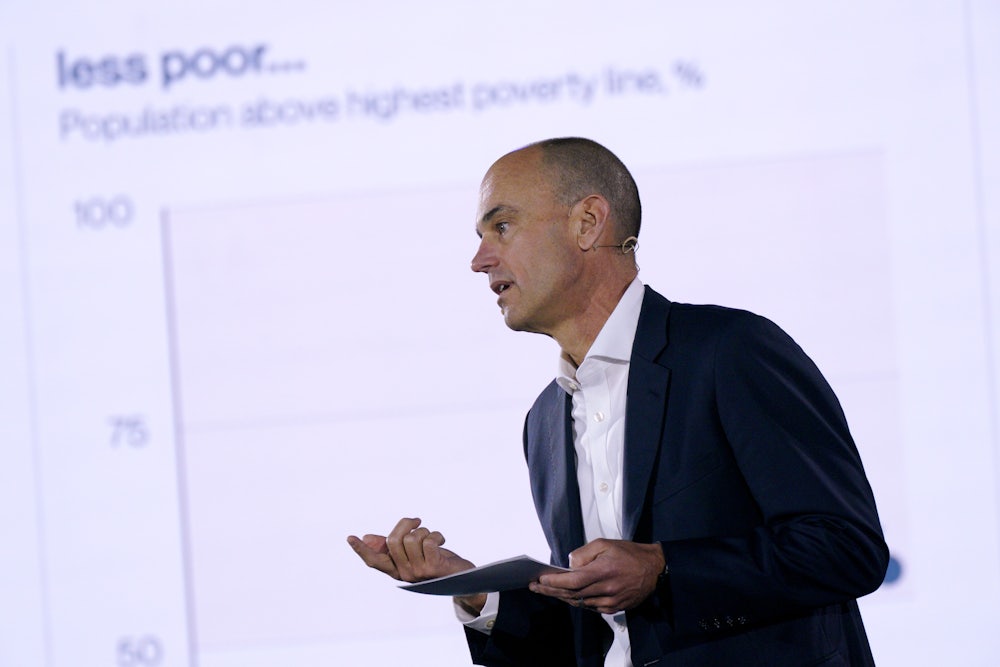In 1961, a has-been Hollywood actor with political ambitions named Ronald Reagan denounced as a stalking horse for socialism a proposal that, on congressional passage four years later, would become Medicare. If Congress mandated government-funded health care for the elderly, Reagan said, the result would be “a mechanism for socialized medicine capable of indefinite expansion in every direction until it includes the entire population. Now we can’t say we haven’t been warned.”
If only. What actually happened was pretty much the opposite. Medicare became a mechanism for spreading not socialism but capitalism, in the sense that the billions gushing forth from the federal government created a for-profit hospital sector where virtually none had existed before. (There’d been some for-profit hospitals during the 1920s, but nearly all of these had been wiped out during the Great Depression, and during the postwar years the federal government had actively discouraged their creation.) As a result of some inspired lobbying by the health care industry, Medicare treated for-profit hospitals very favorably, with the result that today about one-quarter of all community hospitals (what most of us mean when we say “hospital”) are for-profit.
According to an authoritative 2021 paper led by Patrick P.T. Jeurissen of the Netherlands Ministry of Health, for-profit hospitals in the United States and elsewhere have three characteristics:
- They receive a significantly higher return on investment than nonprofit or government-owned hospitals.
- They charge patients more than nonprofit or government-owned hospitals.
- They provide care that is either inferior to or, at best, no better than the care available at nonprofit and government-owned hospitals.
Nonprofits still represent a 58 percent majority of community hospitals, but for-profits continue to outperform nonprofits financially (even as they underperform them in quality of care). For-profits no longer enjoy the favorable treatment that Medicare initially gave them, but a consolidation wave that began in the 1990s boosted profits and expanded market share. It was only a matter of time before the nonprofits addressed their financial woes by aping their for-profit brethren.
According to Senators Elizabeth Warren and Ron Wyden, that day has arrived. A New York Times report from last September by Jessica Silver-Greenberg and Katie Thomas caught their attention. The Times story relayed that many nonprofit hospitals “have become virtually indistinguishable from for-profit companies, adopting an unrelenting focus on the bottom line and straying from their traditional charitable missions.” Warren and Wyden fired off a joint letter Monday to Bob Sternfels, global managing partner of McKinsey, asking about its role in erasing this distinction.
The Times report focused on Providence, a 51-hospital chain based in Washington state founded by the Sisters of Providence in 1856 specifically to provide health services to the poor. By 2018, charity care represented only 1.8 percent of Providence’s expenses, and today it’s dropped below 1 percent.
The rapid drop since 2018 appears to be the result of a program Providence instituted that year after hiring McKinsey to buff up its operations. McKinsey created a program called RevUp; the “rev” stands for revenue. The rev was upped by pressing all patients, including low-income ones, for payment, repeatedly and pretty much relentlessly. According to the Times, six current and former hospital employees working in states that required Providence to provide low-income patients with financial assistance were told not to inform low-income patients of that fact.
McKinsey, of course, is a renowned consulting firm, founded in 1926, whose reputation has taken a serious beating in recent years. Its fingerprints are on, among other catastrophes, the international marketing of cigarettes, Time Warner’s unsuccessful merger with AOL in 2000, the Enron bankruptcy in 2001, and the notably aggressive marketing by Purdue Pharma of OxyContin (for which McKinsey had to pay about $600 million in fines). “McKinsey’s laissez-faire style of management,” write New York Times reporters Walt Bogdanich and Michael Forsyth in their 2022 book When McKinsey Comes To Town, “has allowed its consultants to reap big paydays promoting addictive products, recommending policies that expand income inequality, and serving bad actors on the international stage, including major polluters.”
Warren and Wyden’s letter asks McKinsey to supply a list of all the nonprofit hospitals it has advised on how to increase revenues since 2013; how much McKinsey got paid for this work; whether McKinsey has internal guidelines on avoiding predatory and unethical practices; and whether, in creating the RevUp program, McKinsey considered the impact it might have on access to health care.
If Providence’s mimicking for-profit hospitals has a familiar sound to it, that’s because the story of American medicine for the past 100 years has been one of for-profit providers shoving charitable organizations aside again and again.
As I pointed out in October (“May God Save Us From Economists”), drawing on two excellent books by the reporter Jonathan Cohn, Blue Cross Blue Shield came under pressure in the 1970s and 1980s from for-profit health insurers that, unlike the nonprofit blues, didn’t take all comers and therefore could charge lower rates. By the 1990s the blues were going for-profit themselves. Health Maintenance Organizations, or HMOs, went through the same cycle a decade later, going from nonprofit to profit under competitive pressure. Meanwhile, two Supreme Court cases in the 1970s and 1980s ruled, in effect, that the American Medical Association’s ban on doctors advertising their services and charging above a certain fee constituted “anticompetitive conduct.”
Every time the medical profession has tried to operate under altruistic or philanthropic principles, it’s ended up abandoning them under financial pressure. By now, as I wrote in December (drawing on reporting by ProPublica’s Ava Kofman), even most hospices are for-profit, bought and sold by private equity firms. Why Medicare, which provides most hospice funding, consents to pay for-profit hospice operators, I couldn’t tell you.
Given this history, McKinsey can honestly reply to Warren’s and Wyden’s letter that it’s the American way to sell medical care at the highest price possible. It doesn’t forgive McKinsey’s Providence scheme, but they wouldn’t be lying. Until that way changes, we’ll continue to see the systematic elimination of humane health care for the poor—and a general lowering in the quality of care available to everyone as health care becomes less of a human service and more of a commodity.






